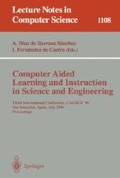Abstract
A simulation environment for physics, called xyZET, has been developed, aimed at supporting the teacher during classroom work and the students for practising and training. xyZET comes in two versions, one with the full control panel, offering access to all didactically meaningful parameters, and a second one with a list of commands to be embedded in html-type documents. An introductory course in mechanics has been developed to demonstrate the potential of this new way of integrating simulation with hypertext.
Preview
Unable to display preview. Download preview PDF.
References
HÄRTEL, H. (1994): COLOS: Conceptual Learning Of Science. In: de Jong T. Sarti L. (ed): Design and Production of Multimedia and Simulation-based Learning Material. Kluwer Academic Publishers, pp 189–217
Page, L. (1924): The Emission Theory of Electromagnetism, Transactions ot the Academy of Arts and Sciences,Vol. 26, p. 213–243, New Haven
Rivers, R.H., & Vockell, E. (1987). Computer simulations to stimulate scientific problem solving. Journal of Research in Science Teaching, 24, 403–415.
Choi, B., & Gennaro, E. (1987). The effectiveness of using computer simulated experiments on junior high school students understanding of the volume displacement concept. Journal of Research in Science Teaching, 24, 539–552.
Shute, V.J., & Glaser, R. (1990). A large-scale evaluation of an intelligent discovery world: Smithtown. Interactive Learning Environments, 1, 51–77.
Faryniarz, J.V., & Lockwood, L.G. (1992). Effectiveness of microcomputer simulations in stimulating environmental problem solving by community college students. Journal of Research in Science Teaching, 29, 453–470.
de Jong, T., van Joolingen, W., Scott, D., de Hoog, R., Lapied, L., Valent, R. (1994). SMISLE: System for Multimedia Integrated Simulation Learning Environments. In T. de Jong & L. Sarti (Eds.) Design and production of multimedia and simulation based learning material (pp. 133–167). Dordrecht: Kluwer Academic Publishers.
Esquembre, F., Härtel, H., Martín, E., Zamarro, J.M. (1996) Integration of Simulation and Hypertext (these proceedings).
Author information
Authors and Affiliations
Editor information
Rights and permissions
Copyright information
© 1996 Springer-Verlag Berlin Heidelberg
About this paper
Cite this paper
Härtel, H., Lüdke, M. (1996). A computer-supported course in mechanics. In: Díaz de Ilarraza Sánchez, A., Fernández de Castro, I. (eds) Computer Aided Learning and Instruction in Science and Engineering. CALISCE 1996. Lecture Notes in Computer Science, vol 1108. Springer, Berlin, Heidelberg. https://doi.org/10.1007/BFb0022629
Download citation
DOI: https://doi.org/10.1007/BFb0022629
Published:
Publisher Name: Springer, Berlin, Heidelberg
Print ISBN: 978-3-540-61491-3
Online ISBN: 978-3-540-68675-0
eBook Packages: Springer Book Archive

